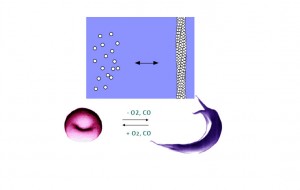“The Physical Foundation of Vasocclusion in Sickle Cell Disease,” a paper written by a team of Drexel researchers, explains how sickle cells cause sickness and how large red blood cells can pass through much smaller pathways. The paper was published in the Oct. 17 issue of the Biophysical Journal.
The team’s study provides a measuring system on which patients can be diagnosed more effectively for treatment.
The relative quantity of hemoglobin within a red sickle cell is the variable that determines the cell’s propensity to harden and at what rate it might harden.
“The amount of hemoglobin varies over time thanks to a loss of water, increasing the degree to which the cells will sickle,” Frank Ferrone, a physics professor and the study’s senior author, said.
The previously accepted hypothesis for sickle cell anemia was that the cells polymerized and became rigid within people’s capillaries. Recent studies done on animals showed that instead of being stopped in vivo within the veins, they were causing problems outside the main capillary. This means that the rigid red blood cells, normally too large to fit into the slender tubes, were being pushed out somehow. Otherwise the results would have been different.
When cells sickle, they become rigid as opposed to a normal red blood cell. Most red blood cells are in fact larger than the capillaries they enter, but by virtue of their malleability they often easily make it through.
Ferrone teamed up with Hongseok “Moses” Noh, a mechanical engineering professor, and Alexey Aprelev, a physics professor, to begin to explore the topic of micro fluidics. This new field provides a previously unattainable level of sophistication and measurement to experimenting on a micro level. It was crucial because to do the same tests on patients would have been considered unethical and uncontrollable due to the innumerable variables. The team was able to engineer what was previously only conceptualized.
 Due to earlier experiments the team had completed, they knew how to measure the amount of hemoglobin in a red blood cell, which would later prove to be the most important variable in determining a cell’s propensity to sickle.
Due to earlier experiments the team had completed, they knew how to measure the amount of hemoglobin in a red blood cell, which would later prove to be the most important variable in determining a cell’s propensity to sickle.
In shortened form, the experiment is “parking the cell in the capillary, in this case an artificial one, polymerizing the cell with carbon monoxide then pushing it out by increasing the pressure,” Ferrone explained.
The artificial tubes they constructed had a cross-section that measured 1.5 nanometers by 4 nanometers. They were made from transparent polydimethylsiloxane.
The sickle cells were then centrifuged to prepare them for the experiment. After “parking the cell,” the environment and the micro channel were saturated with carbon monoxide to instigate polymerization. Steady-state laser illumination removed the carbon monoxide, allowing the hemoglobin to polymerize; then, pressure was applied until the cell was pushed out.
Within a real capillary, the cell would then encounter a “boulder of an adherent cell blocking its path, and this interval is the real danger zone for patients.” Sickle cells polymerize at three different rates, “quickly, intermediately and slowly,” Ferrone said. In a quick polymerization, the cell has the characteristic of “certain escape,” or in other words, it will not become rigid until it passes the large adherent cell outside the capillary. Still relatively safe is an intermediate polymerization of possible escape, where the cells assume a sausage shape within the capillary retaining it until they have passed the second obstruction. During certain occlusion the cells don’t harden until they have passed the capillary, only before reaching the venule wall, in which case the space which they would have previously been constricted to hardening will be much larger.
In this case, theoretical treatments could attempt to speed up the rate of sickling so that they would presumably assume the sausage shape. The only difficulty with this tactic is that the cells that do so very slowly might decrease only to the rate required for them to get stuck.
“[Drexel is] heavily invested in micro fluidics,” Ferrone said. He also said he expects to conduct further research.
Also given credit as an author of the paper was William Stephenson, a recent Drexel graduate who conducted work on this project for his undergraduate senior project in physics, along with Maureen Meier, a nurse at the St. Christopher’s Hospital for Children, who provided the sickle cells used in the experiments.

